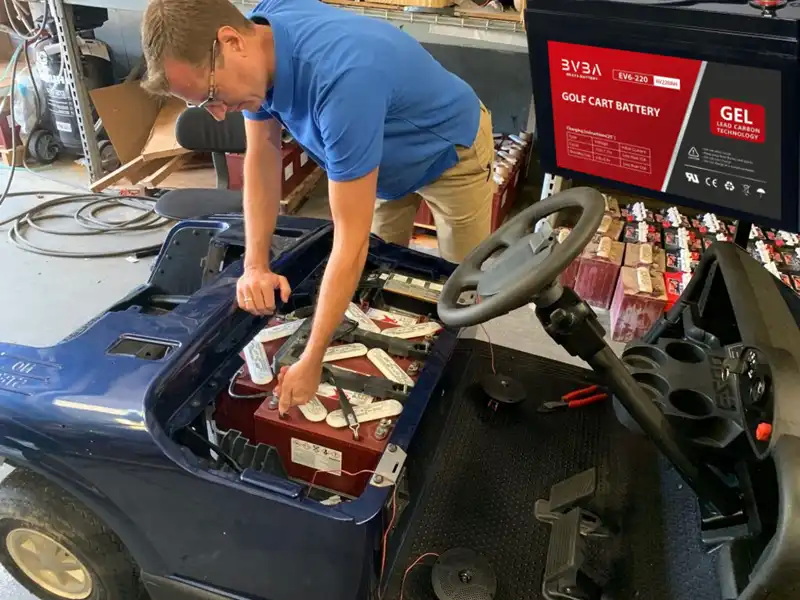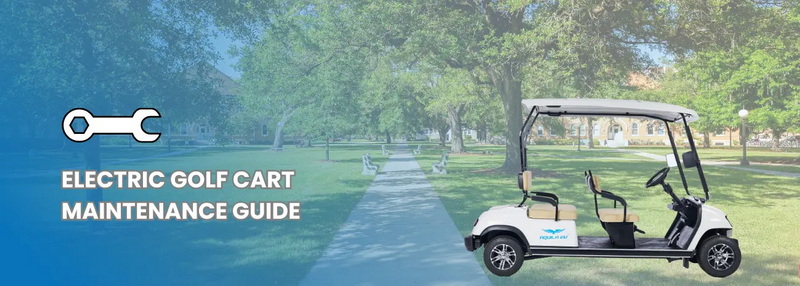Content Menu
● Understanding Electric Golf Cart Batteries
● Importance of Battery Maintenance
● Key Maintenance Practices
>> Regular Charging
>> Watering the Batteries
>> Cleaning the Batteries
>> Storage Practices
>> Monitoring Battery Health
● Troubleshooting Common Battery Issues
>> Charging Issues:
>> Corrosion at Terminals:
>> Battery Not Holding Charge:
>> Water Levels Too Low or High:
>> Age of Battery:
● Conclusion
● FAQ
>> 1. How often should I charge my golf cart battery?
>> 2. Can I use tap water to refill my battery?
>> 3. What are the signs of a failing golf cart battery?
>> 4. How do I prevent corrosion on battery terminals?
>> 5. How long does a typical golf cart battery last?
Maintaining electric golf cart batteries is essential for ensuring their longevity and optimal performance. Proper care not only enhances battery life but also improves the overall efficiency of your golf cart. This comprehensive guide will cover various aspects of battery maintenance, including cleaning, charging, watering, and storage practices.

Understanding Electric Golf Cart Batteries
Electric golf carts typically use lead-acid batteries, although lithium-ion batteries are becoming more popular due to their efficiency and longer lifespan. Understanding the type of battery in your golf cart is crucial as maintenance practices can vary.
Lead-Acid Batteries: These are the most common type in electric golf carts. They require regular maintenance, including checking water levels and cleaning terminals.
Lithium-Ion Batteries: These batteries are more efficient and require less maintenance but still need proper care to maximize their lifespan.
Importance of Battery Maintenance
Proper battery maintenance can significantly extend the life of your golf cart batteries. Neglecting maintenance can lead to reduced performance, shorter lifespan, and costly replacements. Here are some key reasons why maintaining your batteries is vital:
- Enhanced Performance: Well-maintained batteries provide better power output and longer runtime.
- Cost Savings: Regular maintenance can prevent expensive repairs or replacements.
- Safety: Properly maintained batteries reduce the risk of leaks and other safety hazards.
Key Maintenance Practices
Regular Charging
One of the most important aspects of battery maintenance is ensuring that your batteries are charged correctly:
- Charge After Each Use: Always charge your golf cart batteries after every use, regardless of how short the trip was. This prevents deep discharges that can harm the battery.
- Avoid Overcharging: Use a charger with an automatic shut-off feature to prevent overcharging, which can damage the battery.
- Check Charging Environment: Charge your cart in a well-ventilated area to avoid heat buildup and ensure safety.
- Charging Duration: Ideally, charge for 8 to 10 hours after each use to ensure a full charge. This is based on an 80% discharge level, meaning at the time of charging, the batteries would still be at 20% capacity[1][2].
Watering the Batteries
For lead-acid batteries, maintaining proper water levels is crucial:
- Use Distilled Water: Always use distilled water to top off your battery cells. Tap water contains minerals that can damage the battery.
- Check Levels Monthly: Inspect water levels at least once a month. The water should cover the plates inside each cell but not overflow.
- Fill After Charging: Always add water after charging to prevent overflow caused by expansion during charging.
Cleaning the Batteries
Keeping your batteries clean helps prevent corrosion and ensures optimal performance:
- Clean Terminals Regularly: Use a mixture of baking soda and water to clean any corrosion from terminals. This should be done at least once a month[4].
- Inspect for Damage: Regularly check for cracks or leaks in the battery casing that could lead to acid spills or reduced performance.
- Keep Battery Tops Dry: Ensure that the tops of each battery are clean and dry to prevent corrosion from acid buildup[1][5].

Storage Practices
Proper storage is essential, especially during off-seasons:
- Store in a Cool, Dry Place: Keep your golf cart and batteries in a location that is protected from extreme temperatures and humidity.
- Disconnect Batteries for Long Storage: If you plan to store your golf cart for an extended period, disconnect the batteries to prevent slow discharge.
- Charge Every Three Months During Off-season: If storing for long periods, charge the batteries every three months to maintain their health[5][10].
Monitoring Battery Health
Regularly check on the health of your batteries:
- Use a Battery Gauge: A battery gauge can help you monitor the depth of discharge and ensure timely recharging[4].
- Watch for Warning Signs: Be alert for signs of battery trouble such as reduced performance, slow cranking, or visible corrosion on terminals.
Troubleshooting Common Battery Issues
Despite regular maintenance, issues may arise with your golf cart batteries. Here are some common problems and how to troubleshoot them:
Charging Issues:
- Check if the charger is functioning properly.
- Ensure connections are secure.
- Verify that the charger matches the voltage requirements of your battery pack[3][9].
Corrosion at Terminals:
- Clean terminals using a mixture of baking soda and water.
- Ensure connections are tight; loose connections can lead to poor performance[6].
Battery Not Holding Charge:
- Test voltage using a multimeter; healthy batteries should read around 12.5 to 12.7 volts.
- If voltage is low, consider replacing the battery[3][10].
Water Levels Too Low or High:
- Regularly check water levels; maintain them just above the plates.
- Avoid overfilling which can cause acid overflow during charging[4][5].
Age of Battery:
- Monitor performance; if sluggishness occurs after several years (typically 5-7 years), it may be time for replacement[8][9].
Conclusion
Maintaining electric golf cart batteries requires diligence and attention to detail. By following these guidelines—regular charging, proper watering, cleaning, safe storage practices, and monitoring health—you can significantly extend the life of your golf cart's batteries and enhance its overall performance. Remember that a well-maintained battery not only saves you money but also ensures a reliable ride on the course or around your neighborhood.

FAQ
1. How often should I charge my golf cart battery?
You should charge your golf cart battery after every use or at least once a week during periods of infrequent use to prevent deep discharges.
2. Can I use tap water to refill my battery?
No, only use distilled water for lead-acid batteries to avoid introducing impurities that can damage the cells.
3. What are the signs of a failing golf cart battery?
Common signs include slower acceleration, shorter runtime, difficulty charging, and visible corrosion or leaks.
4. How do I prevent corrosion on battery terminals?
Clean the terminals regularly with a baking soda solution and apply a thin coat of petroleum jelly to protect against corrosion.
5. How long does a typical golf cart battery last?
With proper maintenance, most golf cart batteries last between 4 to 6 years.










































